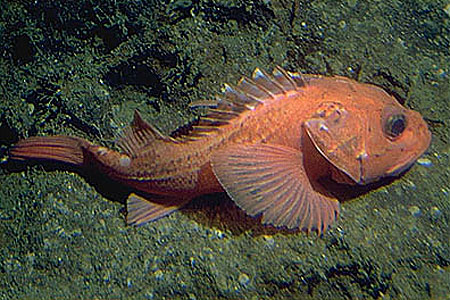| Sebastidae (Rockfishes, rockcods and thornyheads), subfamily: Sebastolobinae |
| 80 cm SL (male/unsexed); max.weight: 9,000.0 g; max. reported age: 100 years |
|
demersal; marine; depth range 17 - 1600 m |
| North Pacific: Sea of Okhotsk north to the Navarin Canyon in the Bering Sea and from Stalemate Bank and Ulm Plateau in the Aleutian Islands southeast to Cedros Island, Baja California, Mexico. Reported from Japan (Ref. 559). |
|
Dorsal spines (total): 15-17; Dorsal soft rays (total): 8-9; Anal spines: 3-3; Anal soft rays: 4-5. Head spines very strong - nasal, preocular, supraocular, postocular, tympanic, parietal and nuchal spines present, coronal spines absent; large head and elongate body; strong spiny ridge on head; 3rd dorsal spine not much longer than 2nd, 4th or 5th; strong notch on pectoral fin (Ref. 27437). Bright red with some black on fins; gill chamber mostly pale (Ref. 27437). Caudal slightly rounded (Ref. 6885). |
| Very common on soft bottoms (Ref. 2850). Oviparous (Ref. 205). Eggs are extruded in floating gelatinous masses (Ref. 31279). Have a thick glandular tissue on posterior margin of fin spines which is believed to be venomous (Ref. 57406). Rarely taken by game fishers (Ref. 27436). Flesh sweeter than that of other rockfishes (Ref. 27436). |
|
Endangered (EN); Date assessed: 01 January 2000 (A2d) Ref. (130435)
|
| venomous |
Source and more info: www.fishbase.org. For personal, classroom, and other internal use only. Not for publication.
